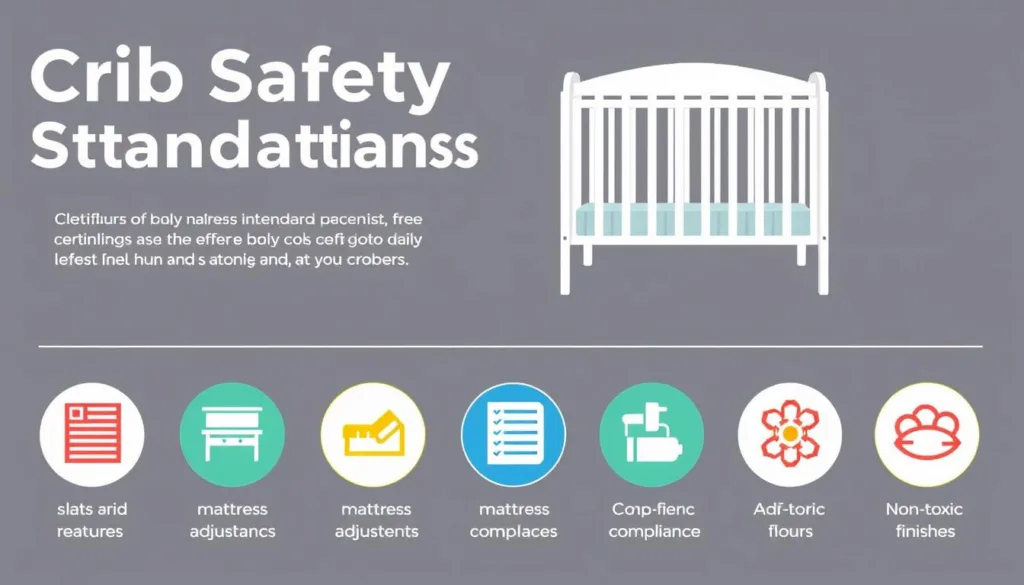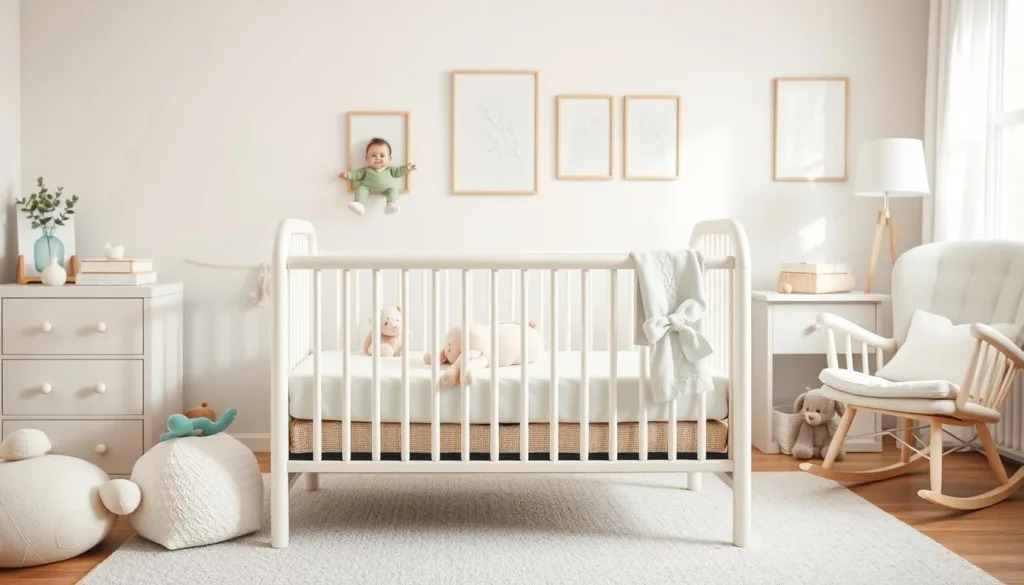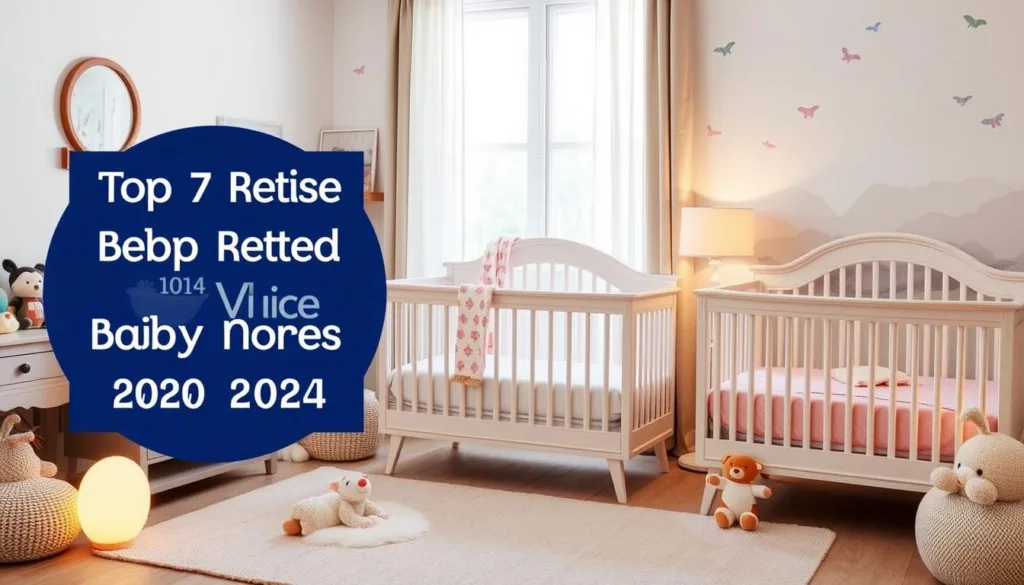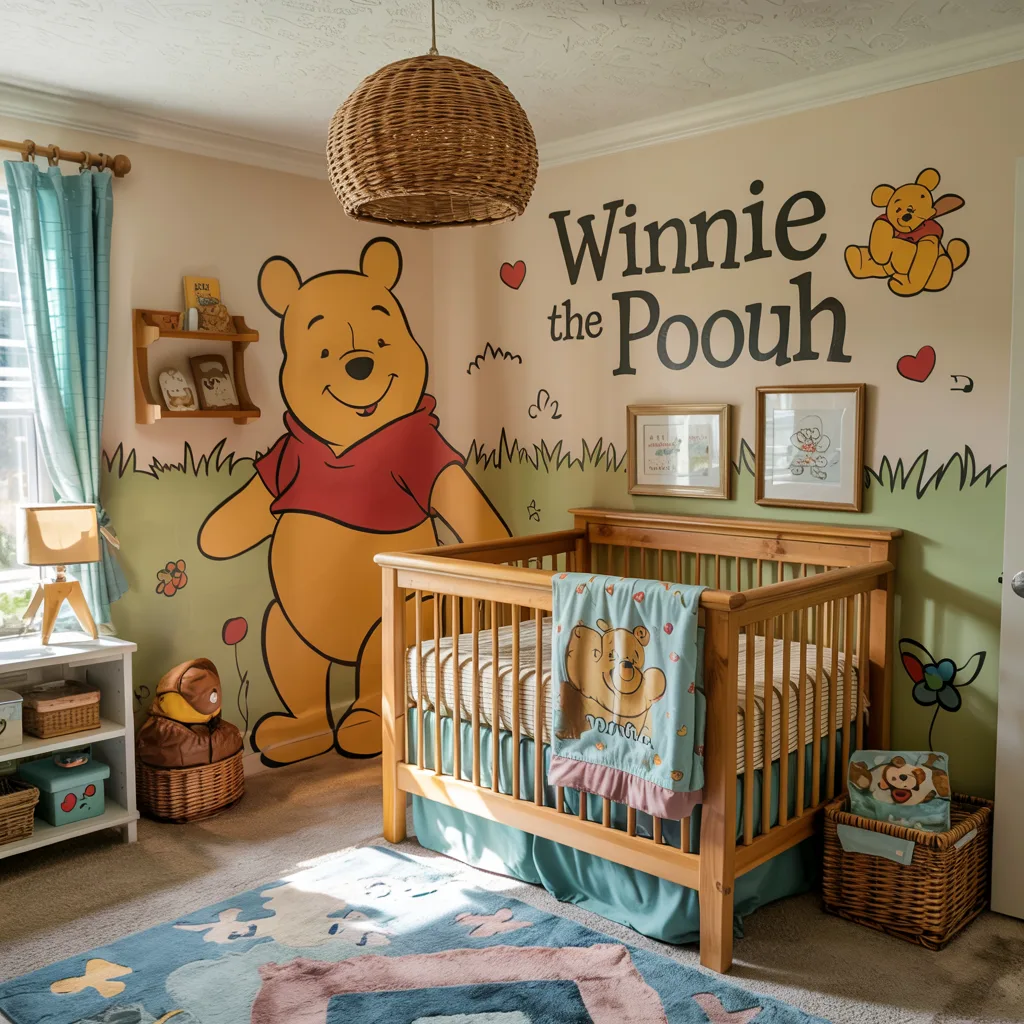Choosing the right crib for your newborn is a big decision. It’s important to think about safety, comfort, and how long it will last. Knowing what to look for can make finding the perfect crib easier.
There are many cribs to choose from, from affordable IKEA options to the high-end Nestig Wave. The best crib is one that keeps your baby safe and grows with them. It’s a smart choice for your baby’s early years.
When you’re looking for a crib, check out features like convertibility and safety standards. Brands like Delta Children, Babyletto, and DaVinci offer cribs that are safe and versatile. They meet strict safety rules and adapt as your child grows.
Key Takeaways
- Prioritize safety certifications when selecting a newborn crib
- Consider convertible cribs for long-term value
- Evaluate weight limits and dimensions carefully
- Choose cribs with adjustable mattress heights
- Budget ranges vary from $179 to $750
- Look for GREENGUARD Gold certification
- Consider portability for modern families
Table of Contents
Understanding Crib Safety Standards and Regulations
Keeping your baby safe while they sleep is crucial. The Consumer Product Safety Commission (CPSC) sets strict rules for cribs. These rules help protect your little one.

In 2022, the American Academy of Pediatrics (AAP) stressed the need for cribs that meet safety standards. These rules are in place to keep your baby safe while they sleep.
CPSC Safety Requirements
The CPSC has set important safety rules for cribs:
- Crib slats must be no more than 2 3/8 inches apart to prevent infant entrapment
- Drop-side cribs are completely banned since 2011
- Mattress supports must be extremely durable
- Hardware must meet stringent quality standards
Materials and Construction Guidelines
When choosing a crib, check the materials and how it’s made. Crib certification means it meets safety standards:
- Non-toxic materials are mandatory
- Greenguard Gold certification indicates low chemical emissions
- Cribs manufactured before 2011 should be avoided
Current Safety Certifications
“Safety isn’t expensive, it’s priceless.” – Unknown
When buying a crib, look for these important safety features:
- CPSC compliance certification
- ASTM International safety standards
- Greenguard Gold certification
- CertiPUR-US foam certification
Knowing these crib safety standards helps you choose the safest crib for your baby.
How to Choose the Best Crib for Newborn
Choosing the right crib for your newborn is a big decision. You need to think about your baby’s safety, comfort, and your family’s needs. It’s important to consider these factors carefully.

When looking at crib features, focus on safety and comfort. These are key for your baby’s well-being.
Essential Crib Features to Consider
- Adjustable mattress height for easy access and safety
- Sturdy construction with rounded edges
- Teething rails to protect the crib from damage
- Wheels for mobility (with locking mechanism)
- Smooth finish to prevent splinters
Understanding Crib Size and Space Requirements
Choosing the right crib size is important for your nursery. Standard cribs are about 28 x 52 inches. Mini cribs are smaller, at 24 x 38 inches.
| Crib Type | Dimensions | Best For |
|---|---|---|
| Standard Crib | 28 x 52 inches | Regular-sized nurseries |
| Mini Crib | 24 x 38 inches | Small spaces, apartments |
Convertible Crib Options
A convertible crib is a great investment. It changes from a crib to a toddler bed, day bed, and even a full-size bed.
“Investing in a convertible crib can save you money and provide a consistent sleep environment for your child as they grow.”
When picking a convertible crib, look for ones with many options. Good ones can change 3-5 times, making your money go further.
- Typical conversions include:
- Newborn crib
- Toddler bed
- Day bed
- Full-size bed
Make sure to measure your space well. Think about your baby’s future needs when deciding between a standard or convertible crib.
Top-Rated Cribs of 2024
Choosing the best cribs for 2024 means looking at safety, function, and style. Today, parents can pick from many top-rated cribs. These cribs are stylish and practical.

After checking many cribs, some models really stand out. They are the favorites for parents who want the best nursery furniture:
- Babyletto Hudson 3-in-1 Convertible Crib
- Storkcraft Equinox 3-in-1 Convertible Crib
- Dream On Me Ashton 5-in-1 Convertible Crib
- Carter’s by DaVinci Colby 4-in-1 Convertible Crib
Safety and versatility are key for these top cribs. Many have Greenguard Gold Certification. This means they have low chemical emissions, giving parents peace of mind.
| Crib Model | Conversion Options | Price Range | Safety Certification |
|---|---|---|---|
| Babyletto Hudson | 3-in-1 | $399-$499 | Greenguard Gold |
| Storkcraft Equinox | 3-in-1 | $299-$399 | ASTM Certified |
| Dream On Me Ashton | 5-in-1 | $249-$349 | JPMA Certified |
“Investing in a quality crib is investing in your child’s safety and comfort.” – Pediatric Sleep Expert
When looking at crib reviews for 2024, think about adjustable mattress heights and convertible designs. Also, consider cribs made from sustainable materials. Your ideal crib should be safe, functional, and stylish.
Budget-Friendly vs Premium Crib Options
Choosing a crib for your newborn involves looking at your budget. The market has many cribs, from affordable to luxury. Each offers something special for new parents.

Value for Money Analysis
When picking a crib, think about your budget and future needs. Here’s a look at what’s available:
- Budget-Friendly Cribs ($199-$300):
- Basic functionality
- Standard safety features
- Limited convertibility
- Mid-Range Cribs ($300-$500):
- Enhanced durability
- More conversion options
- Better materials
- Luxury Cribs ($500-$799):
- Premium wood quality
- Multiple conversion capabilities
- Advanced design features
Long-term Investment Benefits
Choosing a crib is more than just buying something. Convertible cribs are great because they grow with your child. A $500 convertible crib can save you money by lasting longer than buying multiple beds.
Invest wisely in a crib that grows with your child and maintains quality over time.
When picking a crib, think about the materials, how it can change, and if you can sell it later. Your choice should meet your budget now but also last a long time.
Mattress Compatibility and Height Adjustments
Finding the right crib mattress is key for your baby’s comfort and safety. A good fit means your baby sleeps well and stays safe. Most full-size cribs need mattresses that are 27 1/4 inches x 51 5/8 inches.
- Make sure the mattress fits snugly, leaving no more than two finger-width gaps.
- Look for cribs with adjustable height settings (usually 3-4 positions).
- Think about the mattress type: foam, innerspring, latex, or organic.
Today’s cribs have cool height adjustment features. The highest setting is best for newborns, making feeding and diaper changes easier. As your baby gets more active, lower the mattress to stop climbing accidents.
| Crib Model | Height Settings | Suitable Age | Special Features |
|---|---|---|---|
| SnuzPod 4 | 9 settings | Birth to 6 months | Rocking stand, reflux incline |
| Maxi-Cosi Iora | 5 settings | Birth to 6 months | Co-sleeping slide function |
“Choosing the right mattress and crib height is about creating a safe, comfortable sleep environment for your baby.” – Pediatric Sleep Experts
When looking at mattresses, think about firmness, breathability, and dual-sided designs. Innerspring and latex mattresses are great for support and last long. Foam mattresses are affordable and flexible.
When your baby can stand, around 8-10 months, the lowest mattress setting is crucial. It keeps them safe and prevents falls.
Convertible and Multi-functional Crib Designs
Choosing the right convertible crib can change the game for growing families. Modern parents love the versatility of 4-in-1 cribs. These cribs grow with your child, adapting seamlessly.
A growing crib is incredibly flexible. It changes from a baby’s bed to different bed types. Top-rated cribs offer 3-4 changes, with some models having up to 8 options.
4-in-1 Conversion Features
Looking at 4-in-1 cribs, you’ll see these stages:
- Newborn crib
- Toddler bed
- Daybed
- Full-size bed
Growth Adaptation Capabilities
Investing in a convertible crib is smart. It adapts to your child’s needs. Here’s what you should know:
- Almost 50% of convertible crib brands offer multiple bed size conversions
- Over 80% use non-toxic, safe materials
- Prices range from $159 to $529
“A convertible crib isn’t just furniture; it’s a long-term solution for your child’s evolving needs.” – Nursery Design Expert
When picking a convertible crib, look for durability, safety certifications, and versatile design. Brands like Babyletto and IKEA offer great choices. They mix style, function, and affordability.
Material Quality and Durability Factors
Choosing the right crib materials is key for your baby’s safety and comfort. Wood is the top choice, known for its durability and beauty. When picking crib materials, look for factors that make a crib safe and comfy for your newborn.
The most popular wood crib options include:
- Solid pine: Lightweight and affordable
- Oak: Extremely durable and long-lasting
- Maple: Resistant to wear and tear
- Beech: Sturdy and aesthetically pleasing
When looking for a durable crib, don’t just focus on the wood. Certification matters. Look for cribs with:
- GREENGUARD Gold Certification
- Non-toxic finishes
- Lead-free paint
- Formaldehyde-free adhesives
“A high-quality crib is an investment in your child’s safety and comfort.” – Pediatric Sleep Experts
Hybrid materials are becoming more popular. They mix different material strengths for new crib designs. Metal parts like iron or aluminum add stability, while wooden frames offer warmth and classic looks.
A durable crib should last through teething, active play, and even for future kids. Focus on quality construction and materials that meet strict safety standards. This ensures your baby’s safety and comfort.
Assembly and Maintenance Guidelines
Setting up a safe and cozy crib for your newborn is important. You need to know how to assemble and maintain it well. This ensures your baby’s safety and keeps the crib in good shape for longer.
Setup Instructions for Safe Crib Assembly
Assembling a crib needs careful attention. Here are the key steps for a safe and proper setup:
- Read the manufacturer’s instructions completely before starting
- Organize all hardware and tools before beginning assembly
- Ensure a clean, spacious work area
- Check that all components are present and undamaged
- Tighten all screws and bolts securely
Comprehensive Crib Maintenance Strategies
Keeping your crib in good condition is important. Regular checks help spot any problems early.
| Maintenance Task | Frequency | Purpose |
|---|---|---|
| Hardware Check | Weekly | Verify all connections remain tight |
| Clean Crib | Monthly | Remove dust and potential allergens |
| Paint Touch-ups | As needed | Prevent wood damage and rust |
Cleaning and Care Tips
Cleaning your crib gently is important. It helps keep it safe and in good shape:
- Use mild, baby-safe soap for cleaning
- Avoid harsh chemical cleaners
- Wipe down surfaces with a soft, damp cloth
- Dry thoroughly to prevent wood warping
“A well-maintained crib is a safe crib. Regular care protects both your investment and your child.”
By following these steps, you’ll make a safe and comfy crib for your newborn. Remember, consistent care is key to long-lasting crib performance.
Style and Aesthetic Considerations
Choosing the right crib design can make your nursery stunning. It shows your personal style and makes the room warm and inviting. Think about how different elements work together for a cohesive look.
Key style considerations for your crib design include:
- Color palette coordination
- Furniture finish compatibility
- Room theme integration
- Visual texture and material selection
Modern nursery decor offers a wide range of crib styles. You can find everything from classic sleigh designs to modern geometric shapes. Popular colors include:
- Natural wood tones
- Crisp white
- Soft gray
- Elegant black
- Two-tone finishes for visual interest
“Your nursery should tell a story – make it personal, make it yours.” – Interior Design Expert
When picking your crib, think about more than looks. Consider how the design will grow with your child. Many cribs today can change as your child grows, offering versatility.
Budget-friendly tip: Look for furniture collections from brands. They help you create a cohesive nursery without spending too much. Some 3-in-1 cribs start at just $399, offering both style and value.
Conclusion
Choosing the right crib for your newborn is very important. It must be safe, comfortable, and practical. The Consumer Product Safety Commission (CPSC) offers guidelines to help parents choose the best crib for their baby.
When picking a crib, look for safety certifications and strong construction. These are key to ensuring your baby’s safety. The American Academy of Pediatrics suggests keeping your baby’s sleeping area in your room for the first six months.
This makes choosing a safe and versatile crib even more crucial. Look for cribs with breathable mesh sides and adjustable height positions. Also, make sure they have strong safety features to protect your baby.
While budget is important, never sacrifice safety. Brands like DaVinci and IKEA offer affordable cribs that are safe. Always pair your crib with a firm, well-fitted mattress and follow safe sleep guidelines.
The right crib will grow with your child, offering both immediate safety and long-term value. By doing your research and focusing on your baby’s safety, you’ll create a safe and comfortable space. This will support your baby’s healthy sleep development in the first years of life.
FAQ
What are the key safety standards for cribs in the United States?
Cribs sold in the US must meet Consumer Product Safety Commission (CPSC) rules. They need stationary sides, strong supports, and durable parts. Cribs should also have proper slat spacing and no drop-side designs. Look for GREENGUARD Gold Certification for safe materials.
How long can I use a typical crib for my child?
Cribs are used for about 4 years. Many cribs can change into toddler beds at ages 2-3. Some models can even become full-size beds.
What size crib should I choose for my nursery?
Cribs come in sizes like full-size (28 x 52 inches) and mini (24 x 38 inches). Make sure the mattress fits well, leaving just a little room.
How much should I expect to spend on a good quality crib?
Cribs cost between 9 to 0. Budget options start at 9. Mid-range cribs are around 9. Premium cribs offer more features and last longer.
What features should I look for when buying a crib?
Look for adjustable height, teething rails, and mobility wheels. Safety certifications and convertibility are important. Choose cribs made from non-toxic materials.
Are drop-side cribs still available?
No, drop-side cribs were banned in 2011. Today, all cribs have stationary sides for safety.
What are the top-rated cribs for 2024?
The best cribs for 2024 include the Storkcraft Equinox and Dream On Me Ashton. Also, the Carter’s by DaVinci Colby, Graco Benton, Union, Evolur Julienne, and Babyletto Hudson. They offer various features and styles.
How do I ensure my baby’s crib is safe?
Use a firm mattress and a tight sheet. Keep the crib clear of soft bedding. Place your baby on their back. Follow the American Academy of Pediatrics guidelines. Check the crib often for damage.
What materials are best for cribs?
Cribs are made from solid wood, engineered wood, and metal. Look for non-toxic finishes and GREENGUARD Gold Certification. This ensures safety and durability.
How often should I replace or upgrade my baby’s crib?
Replace your crib if it’s over 10 years old or doesn’t meet safety standards. Check for wear and recalls. Always follow manufacturer guidelines and stay updated on safety.











